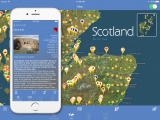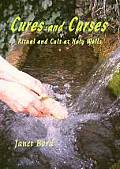<< Events >> 'Proto Stonehenge' discovered in West Wales
Submitted by Andy B on Monday, 09 June 2014 Page Views: 11158
EventsCountry: Wales Type: Stone CircleInternal Links:

It provides a second and unconnected link between the Preseli hills and Stonehenge, supporting the argument that the bluestones were taken to Stonehenge ' at vast expense of toil' by human action.
This is a significant moment in our understanding of what Thom called megalithic science and what most archaeologists have called the lunatic fringe. It is going to be very hard to dismiss what I have found, and I have involved several significant others in checking it out. Green lights from them all.
STONEHENGE – The Welsh Connection
Presentation, Exhibition, Book Launch and Q&A session by Robin Heath
At the Small World Theatre, Cardigan, Wales on Sunday the 22nd June at 1:30 pm
A (very) Brief History of Modern Attempts to understand Stonehenge. Stonehenge evolved over fifteen centuries. The early phases of the monument began around 3150 BC and consisted of a 380 foot (115m) diameter circular bank, which created a ditch outside the circle. Inside the circular arena was an alignment to the solstitial sunrise, through a break in the bank to the Heel stone. A century later, 56 large holes were dug around the perimeter of an accurate 283 foot (86m) circle, now known as the Aubrey circle after the antiquarian John Aubrey, who discovered the remains of these holes. Current ideas are that these holes may once have held wooden posts or even bluestones.
About a century further on, a bluestone semi-circle was built in the centre, which had lintels carried aloft long 8ft slender uprights. This was truly a proto-Stonehenge, for in the middle of building this first architectural structure, a much more ambitious project was about the be initiated, that of hauling seventy five huge sarsen sandstones, some weighing in at forty tons, from the Marlborough Downs, twenty miles north of Stonehenge, near Avebury stone circle. This became the 100 ft diameter sarsen circle and the trilithon horseshoe. Prior to the arrival of these monsters, perhaps around 2800 BC, four standing stones were placed around the perimeter of the Aubrey circle to define a ‘near perfect’ rectangle whose side lengths were in the ratio 5:12.
The sarsen structures at Stonehenge, the circle and the five bigger trilithons that rise up inside the circle, are the logo that everyone thinks of when the word Stonehenge is mentioned. However, this is the grandiose later structure, and the earlier phases are just as important. There are still the remains of most of the bluestones on site. Some were very polished, some still have the tenon or mortice joints that must have once enabled them to form a trilithon structure in the earlier bluestone ‘henge’. These recycled bluestones were placed in a bluestone circle within the sarsen circle or in a horseshoe arrangement within the trilithons.
Stonehenge in Modern (post-Roman) Times
The link between Stonehenge and West Wales goes back much further than one might think, Carmarthen-born legend Merlin claimed that the Stones arrived from Ireland, in a fanciful tale invoking giants, yet in his lifetime, West Wales was administered by the Irish and even the language spoken here was Irish. But there’s another problem with Merlin’s tale – the stones to which he refers are the giant sarsen stones, which weigh up to 40 tons, not the bluestones which weigh in at a tenth of this.
In 1603 a local Pembrokeshire nobleman, George Owen, who, according to a brass plaque in Nevern church was ‘The Patriarch of English(!) Geologists’, made a connection between the stones and the design of Pentre Ifan and Stonehenge. And in 1655, Architect General to the King, Inigo Jones made the first well popularised (and very inaccurate plan) of the inner part of Stonehenge, for King James I. Major archaeological surveys of the monument have been undertaken during the last two centuries.
Sir William Flinders Petrie, the ‘father of modern archaeology’, accurately surveyed the inner part of Stonehenge in the 1870s, before he was twenty years old. IN the early part of the twentieth century, Col Hawley spent years excavating the site, adding greatly to our knowledge of what Stonehenge had once been. In the 1950s professor Richard Atkinson, from UCSW, Cardiff, devoted many years to another major survey, and one outcome was a bestselling book called simply, Stonehenge, published in 1956 by Hamish Hamilton. In 1973, Atkinson asked ‘the father of modern archaeoastronomy’ professor Alexander Thom, to undertake ‘the most accurate survey ever undertaken of the monument at ground level’.
The Matter of the Bluestones
In the Preseli mountains of coastal West Wales, there are several volcanic outcrops that during the past ninety years have been identified as the source of the bluestone megaliths at Stonehenge. In 1923, Geologist Dr H H Thomas published an academic paper suggesting that many of the Stonehenge bluestones had come the Preselis. This discovered has fuelled along standing debate, acrimonious at times, as to whether these stones arrived at Stonehenge through deliberate human intent, or by the action of glacial flow.
Recent work by professor Mike Parker Pearson (UCL), and geologists from Aberystwyth University, has employed improved petrological analyis to begin the process of identifying the source of each of the bluestones that now remain at Stonehenge.
Supposing it can ever be proved that human endeavour was responsible for moving these 4 ton monsters all the way from Preseli to Salisbury Plain, then beyond marvelling at the engineering and cooperative skills shown by our distant ancestors, a much bigger question needs to be answered. That question is why they should have moved these stones over 150 miles? What purpose was being served by moving them? Robin Heath now claims to have an answer.
Robin is an independent researcher and author of three books on Stonehenge. He has been working for over twenty-five years to find an answer to this question, and that answer is to be found in the landscape of West Wales, near Newport, Pembrokeshire. In the summer of 2013 he discovered a previously unknown megalithic complex, a Proto Stonehenge, forging a second link has been forged between the Preseli region of Wales and Stonehenge.
This discovery, duly surveyed with modern theodolites , GPS and satellite imagery, reveals that Stonehenge was the end result of a long project undertaken over several centuries. The goal was to develop a Neolithic technology capable of accurately measuring and recording time and space. Breathtakingly accurate, what has been discovered is a work of creative genius, completely lost until now and totally absent from our history books. Once understood, it allows us to lift the capabilities of Neolithic culture to a new level and reveals a practicalprehistoric science with which to integrate the rhythms and cycles of the sky with those experienced on earth.
The Small World Theatre Event
The forthcoming presentation of this discovery takes place at the Small World Theatre, Cardigan, and is appropriately timed for the midsummer solstice period, on Sunday June 22nd. A small exhibition with large models will also be available, and Robin will be launching his new book, Proto-Stonehenge in Wales, to begin telling a new story about how Stonehenge came to be, and why, and how our ancestors forged the earliest known beginnings of astronomy and surveying in West Wales.
Biography
Robin Heath is an independent researcher and for over twenty five years has lectured widely, in Britain, Ireland and France, undertaking tours, presentations, workshops and media interviews on the ancient megalithic sciences. An internationally published author of seven books on the subject of megalithic science, including four with Stonehenge in their title, Robin’s book Stonehenge (Wooden Books, 2000) has remained a best-seller at the monument. Previously the head of technology at Coleg Ceredigion, for the past thirty years Robin has lived in the Preseli region of West Wales.
Bibliography
Robin Heath is the author of A Key to Stonehenge (1993), Sun, Moon & Stonehenge (1998), Sun, Moon & Earth (1999), A Beginner’s Guide to Stone Circles, Hodder-Headline (1999), Stonehenge (2000), The Measure of Albion (with John Michell, 2004), The Lost Science of Measuring the Earth (2006), Powerpoints (2007), and Bluestone Magic (2010).
Further details are available at www.skyandlandscape.com or www.robinheath.info
Note: Megalithic Portal Exclusive

<< Get involved with the Day of Archaeoastronomy at the summer solstice 2014
Summer Solstice at Stonehenge 2014 Information and Travel details >>






 We would like to know more about this location. Please feel free to add a brief description and any relevant information in your own language.
We would like to know more about this location. Please feel free to add a brief description and any relevant information in your own language. Wir möchten mehr über diese Stätte erfahren. Bitte zögern Sie nicht, eine kurze Beschreibung und relevante Informationen in Deutsch hinzuzufügen.
Wir möchten mehr über diese Stätte erfahren. Bitte zögern Sie nicht, eine kurze Beschreibung und relevante Informationen in Deutsch hinzuzufügen. Nous aimerions en savoir encore un peu sur les lieux. S'il vous plaît n'hesitez pas à ajouter une courte description et tous les renseignements pertinents dans votre propre langue.
Nous aimerions en savoir encore un peu sur les lieux. S'il vous plaît n'hesitez pas à ajouter une courte description et tous les renseignements pertinents dans votre propre langue. Quisieramos informarnos un poco más de las lugares. No dude en añadir una breve descripción y otros datos relevantes en su propio idioma.
Quisieramos informarnos un poco más de las lugares. No dude en añadir una breve descripción y otros datos relevantes en su propio idioma.